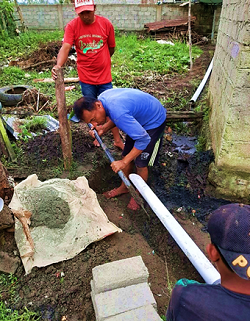IPAL Komunal dalam Mengolah Limbah Rumah Tangga di Desa Dutohe Barat Communal Wastewater Treatment in Household Waste Treatment in Dutohe Barat Village
Main Article Content
Abstract
The village of Dutohe Barat is classified as an emergency sanitation area due to household waste produced by human activities (bathing, washing, and cooking). This activity aims to solve the problem by designing and making the communal wastewater treatment that has been standardized. The sample is liquid waste collected from 5 houses in section 4. Initial data on wastewater quality were obtained were BOD, which initially was 265 mg/l, COD was 290 mg/l, and oil and fat were 27 mg/l. The activity method is carried out in 3 stages (observation, socialization, and evaluation). After going through treatment with this communal wastewater treatment, the results of the reduction in waste pollutants were BOD decreased to 98 mg/l, COD decreased to 90 mg/l, and oil and fat decreased to 10 mg/l. In addition, the output from the wastewater treatment processing is used by farmers to irrigate crops.
Downloads
Article Details
Authors who publish with this journal agree to the following terms:
- Any article on the copyright is retained by the author(s).
- Author grant the journal, right of first publication with the work simultaneously licensed under a Creative Commons Attribution License that allows others to share work with acknowledgment of the work authors and initial publications in this journal.
- Authors are able to enter into a separate, additional contractual arrangements for non-exclusive distribution of published articles of work (eg, post-institutional repository) or publish it in a book, with acknowledgment of its initial publication in this journal.
- Authors are permitted and encouraged to post their work online (e.g., in institutional repositories or on their websites) prior to and during the submission process, as can lead to productive exchanges, as well as earlier and greater citation of published work.
- The article and any associated published material is distributed under the Creative Commons Attribution-ShareAlike 4.0 International License
References
Dinas Kesehatan Bone Bolango. 2013. Laporan Sanitasi Dasar. Gorontalo: Dinas Kesehatan Bone Bolango
Ermayda, R.Z., Nanda, H.I., Fatikhah, D.N. 2019. Mengolah Limbah Rumah Tangga untuk Meningkatkan Konsumsi Mandiri. Jurnal Karinov. 2(1):39–46. http://dx.doi.org/10.17977/um045v2i1p39-46
Ghawi, A.H. 2018. Study on the development of household wastewater treatment unit. Journal of Ecological Engineering. 19(2):63–71. https://doi.org/10.12911/22998993/81780
Hasibuan, R. 2016. Analisis Dampak Limbah/Sampah Rumah Tangga Terhadap Pencemaran Lingkungan Hidup. Jurnal Ilmiah Advokasi. 4(1):42–52. https://doi.org/10.36987/jiad.v4i1.354
Junaedi, A., Hasanah, U.A. 2014. Penyuluhan tentang penanganan limbah rumah tangga. AJIE (Asian Journal of Innovation and Entrepreneurship). 3(2):111–114
Khumaidi, A., Rahayu, T., Darmiyanti, L. 2019. Sosialisasi Penanganan Air Limbah Rumah Tangga Di Karawang. Jurnal Solma. 8(2):287-294. https://doi.org/10.29405/solma.v8i2.3165
Marliani, N. 2014. Pemanfaatan Limbah Rumah Tangga (Sampah Anorganik) Sebagai Bentuk Implementasi dari Pendidikan Lingkungan Hidup. Formatif : Jurnal Ilmiah Pendidikan MIPA. 4(2):124-132. http://dx.doi.org/10.30998/formatif.v4i2.146
Nilasari, E., Faizal, M., Suheryanto, S. 2016. Pengolahan Air Limbah Rumah Tangga dengan Menggunakan Proses Gabungan Saringan Bertingkat dan Bioremediasi Eceng Gondok (Eichornia crassipes), (Studi Kasus di perumahan Griya Mitra 2, Palembang). Jurnal Penelitian Sains. 18(1):8-13. https://doi.org/10.26554/jps.v18i1.34
U.S. Environmental Protection Agency. 2002. Onsite Wastewater Treatment Systems Manual. https://www.epa.gov/sites/default/files/2015-06/documents/2004_07_07_septics_septic_2002_osdm_all.pdf
